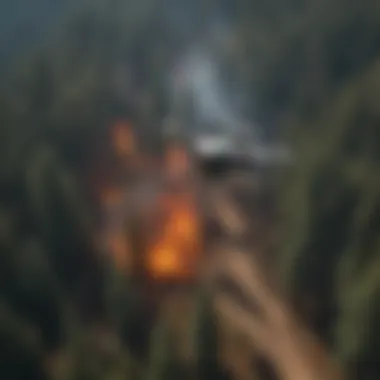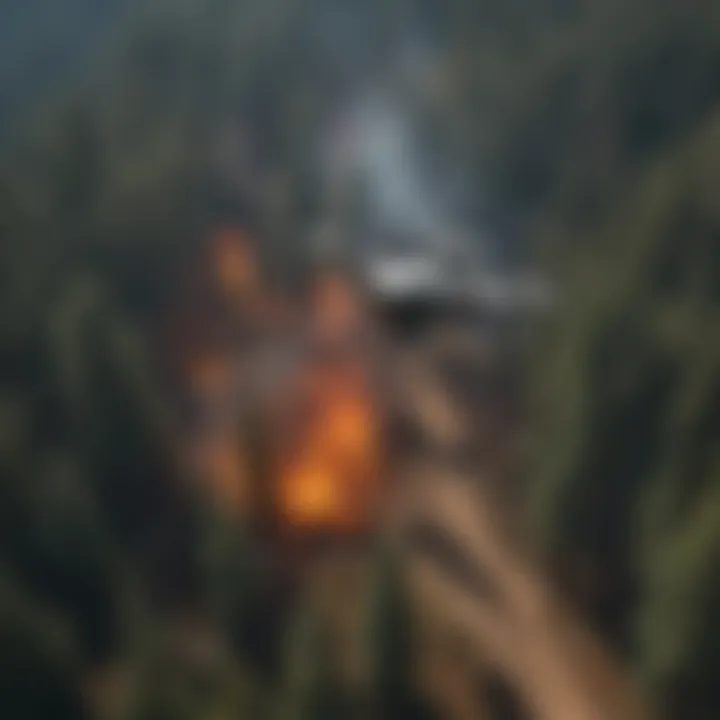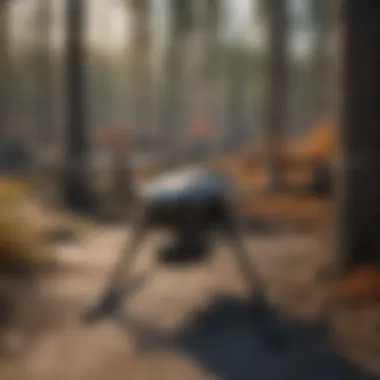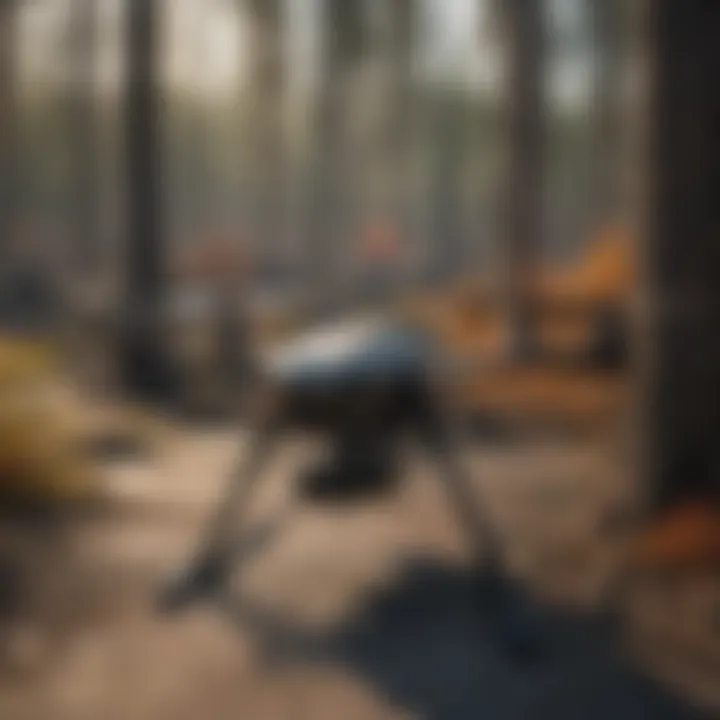Drones Revolutionizing Wildfire Management Strategies


Intro
Drones are becoming increasingly relevant in the realm of firefighting, especially for managing wildfires. The rise of these technological tools opens new possibilities for improving response times and enhancing the safety of firefighters. Their integration into existing operational frameworks can transform the way wildland fires are detected, monitored, and fought. As we delve deeper into this article, we will explore not only the capabilities of drones but also the challenges they pose in regulatory frameworks and practical application.
Understanding Woodland Ecosystems
Importance of Biodiversity in Forests
Forests are rich in biodiversity, which is vital for ecological balance. Many species depend on these ecosystems for habitat and food. The loss of biodiversity can lead to weakened ecosystems, making them more susceptible to diseases and pests, which in turn can increase the frequency and severity of wildfires. By preserving biodiversity, we enhance the resilience of forests against various environmental stresses, including fire.
Role of Forests in Climate Regulation
Forests are crucial in regulating climate. They absorb carbon dioxide, a significant greenhouse gas, and provide oxygen. As the climate changes, the role of forests becomes even more critical. Wildfires release stored carbon back into the atmosphere, contributing to climate change. Thus, effective management and protection of forests are essential not just for biodiversity, but also for climate stability.
Drones in Wildfire Management
Drones have become powerful tools in wildcard management. Their ability to fly over difficult terrain allows for efficient monitoring and data collection. They can detect temperature anomalies and provide real-time information to firefighting teams. The technology enhances the situational awareness of responders and assists in assessing the extent of a fire.
Current Applications of Drones
- Fire Detection
Drones equipped with thermal imaging cameras can detect hotspots long before they become visible flames. This allows for earlier intervention and containment. - Surveillance
During wildfires, drones can survey affected areas. They provide valuable aerial footage, helping teams make informed decisions without putting pilots at risk. - Support in Suppression Activities
Drones can be used to deliver emergency supplies or deploy fire retardants directly over inaccessible areas.
Drones redefine traditional methods of firefighting by bridging the gap between technology and practical operational needs. Their capabilities allow for proactive measures, enhancing efficiency in response strategies.
Limitations and Challenges
While drones offer numerous advantages, they also come with certain limitations. Weather conditions can affect drone performance, limiting their use in extreme winds or rain. Moreover, regulatory challenges exist as airspace restrictions apply in many firefighting scenarios. Clear guidelines and training for operators are crucial to maximize drone efficiency and safety in rescues.
Finale
As we continue to explore the intersection of technology and environmental management in firefighting, understanding its implications is important. Innovations like drones can lead to a new era in wildfire management, but it is essential to continue evaluating the challenges and ensuring responsible implementation of these advancements.
Prolusion to Drones in Firefighting
The integration of drones into firefighting strategies marks a significant shift in how wildfires are managed. This section discusses the potential advantages that drones offer to firefighting efforts while also considering vital elements surrounding their implementation.
Firefighters face challenges related to safety, situational awareness, and resource allocation. Drones provide innovative solutions that enhance the efficiency of wildfire management. Their use can decrease the risk that firefighters encounter in the field. Instead of risking human lives in dangerous areas, drones can assess situations remotely, offering real-time data and images.
Overview of Drone Technology
Drones, or Unmanned Aerial Vehicles (UAVs), have rapidly evolved from military applications to civilian use in various sectors, including firefighting. Current drone technology can range from small quadcopters to larger fixed-wing models. These devices are equipped with advanced sensors, cameras, and mapping tools. Features often include:
- High-definition cameras for real-time video feeds.
- Thermal imaging sensors for detecting heat sources.
- GPS technology for accurate navigation.
This development allows drones to function in numerous capacities during firefighting operations. Their ability to cover large areas quickly while collecting data is especially beneficial during wildfires, which can spread unpredictably.
Emergence of Drones in Emergency Response
The emergence of drones in emergency response is a relatively recent phenomenon. Over the years, natural disasters have highlighted the limitations of traditional firefighting techniques. During wildfires, access to real-time information is crucial. Drones have been deployed in various situations, enhancing the situational awareness of firefighters. They are now recognized as a valuable asset in the emergency response toolkit.
Several incidents, such as the devastating wildfires in California and Australia, have prompted agencies to adopt drone technology. The increased demand for effective monitoring led to investments in UAV technology. This shift has improved communication among firefighting teams, facilitating better decision-making in critical moments. As a result, the role of drones in firefighting continues to expand.
"Drones represent a transformative approach to wildfire management, allowing for safer, faster, and more informed responses during emergencies."
In summary, drones are changing the landscape of firefighting. Their capabilities not only assist in immediate responses but also improve long-term wildfire management strategies.
Capabilities of Drones
Drones are transforming firefighting and wildfire management with their unique capabilities. These aerial vehicles can perform tasks that were previously difficult, dangerous, or time-consuming for traditional ground crews. By utilizing drones, firefighting agencies can improve efficiency, response times, and overall scene management. The advancements in drone technology are crucial in enhancing firefighting tactics and strategies.


Aerial Surveillance and Reconnaissance
Aerial surveillance is a primary capability of drones. They enable real-time monitoring of vast terrains, making it easier for responders to assess wildfire conditions. Drones can capture high-resolution images and video, providing detailed insights into the fire's size, location, and spread. This information is vital for decision-making processes in firefighting operations.
- Drones can cover areas that might be too hazardous for manned aircraft or ground crews, minimizing risk to personnel.
- Continuous surveillance helps track changes in fire behavior, allowing for timely adjustments in strategy.
- The data retrieved can be shared instantly with all stakeholders involved, ensuring everyone is informed about the current situation.
"The ability to access difficult terrains remotely allows for safer and more effective firefighting operations."
Thermal Imaging for Heat Detection
Thermal imaging technology significantly enhances drone capabilities. It allows drones to detect heat signatures of wildfires, even through smoke and dense vegetation. This ability is crucial for early detection and monitoring of fires.
- Thermal drones can identify hotspots, which helps firefighters target suppression efforts more effectively.
- By detecting temperature variations, responders can assess areas that may not be visibly on fire but could flare up.
- The technology aids in determining the remaining resources of fuel, enhancing predictive modeling.
Real-Time Data Collection and Analysis
Drones excel at providing real-time data collection vital for effective wildfire management. They gather precise information about aerial conditions, such as wind speed and direction, humidity levels, and temperature.
- This data can be processed and analyzed quickly, leading to informed tactical decisions on the ground.
- With the integration of GIS (Geographic Information System) mapping, responders can visualize fire spread on their maps, leading to better strategic planning.
- The efficiency of response efforts increases, facilitating targeted actions rather than generalized ones.
In summary, the capabilities of drones in firefighting are extensive. From enhancing surveillance and reconnaissance operations to utilizing thermal imaging for effective heat detection, drones are indispensable tools in modern wildfire management. Their real-time data collection capabilities further improve decision-making processes and overall firefighter safety.
Applications of Drones in Fire Management
In the field of fire management, drones provide significant advantages that enhance efficiency and effectiveness. They equip firefighters with advanced tools for handling wildfires, ultimately saving lives and resources. The use of drones can be broken down into distinct applications, each playing a crucial role in modern firefighting strategies. By integrating these aerial systems into fire management practices, officials can improve response time, gather essential data, and make informed decisions during critical situations.
Fire Detection and Early Warning Systems
Early detection of wildfires is crucial. Drones equipped with thermal imaging cameras can identify hotspots and detect fires in their infancy stage. This technology enables firefighters to react quickly, potentially preventing a small fire from escalating into a larger crisis. The ability to assess vast areas in a short time frame gives teams an edge in assessing fire risks.
When integrating drones into fire detection systems, it is important to establish standard operating procedures. Firefighters should train on how to operate these devices effectively and interpret the data accurately. Additionally, combining drone surveillance with ground-based systems can enhance overall monitoring capabilities. This dual approach can lead to more comprehensive fire management strategies and improved situational awareness.
Monitoring Fire Spread and Behavior
Once a wildfire is detected, understanding its behavior is essential for effective containment. Drones play a pivotal role in real-time monitoring of fire spread. They can cover large areas and provide high-resolution imagery, helping teams to visualize the fire's path and intensity. By analyzing this data, firefighters can adapt their strategies to better control the situation.
Moreover, drones can assist in forecasting fire behavior by integrating environmental data such as wind speed and temperature. This information can be used to simulate different scenarios, allowing teams to develop contingency plans. Furthermore, continuous monitoring enables quick adjustments to firefighting efforts, significantly improving the chances of successfully containing wildfires.
Supporting Firefighting Operations
Beyond detection and monitoring, drones offer direct support to firefighting operations. They can deliver supplies, such as water or fire retardants, to inaccessible areas where crews might struggle to reach safely. This capability not only saves time but also enhances the safety of ground personnel by minimizing their exposure to hazardous situations.
Additionally, drones can assist in communication among team members. Equipped with cameras and transmission capabilities, they provide a bird’s-eye view of the terrain. This perspective is valuable during briefings and can facilitate better strategic planning. Visually sharing data and images from the operation site allows for cohesive decision-making and coordination.
The key takeaway is that the diverse applications of drones in fire management present a transformative approach to combating wildfires. By harnessing these technologies, firefighting agencies can significantly improve their operational effectiveness, ultimately leading to safer and more efficient wildfire management.
Case Studies of Drone Use in Wildfires
Understanding the real-world applications of drone technology is essential for grasping its impact in firefighting. Case studies provide concrete examples of how drones have been deployed in actual wildfire situations. They allow us to evaluate the effectiveness of drones in various scenarios and highlight the benefits and challenges associated with their use in fire management.
Through these case studies, it becomes clear that drones are not merely an emerging tool; they have actively reshaped how firefighting is conducted. These real-life examples underscore the importance of integrating drone technology into established fire response strategies. Furthermore, studying these deployments aids in assessing best practices and informs future improvements in technology and operational procedures.
Successful Deployments in the Field
A notable case study involves the deployment of drones during the 2018 Mendocino Complex Fire in California. This incident was one of the largest wildfires recorded in California's history. Drones were utilized for aerial surveillance to track fire dynamics, providing firefighters with critical information on fire spread and intensity.
Drones captured high-resolution imagery and thermal data that helped teams make informed decisions. Firefighters were able to identify hotspots and areas at risk of ignition, which ultimately enhanced their operational strategy. Moreover, the real-time communication of data improved coordination between various firefighting units on the ground, indicating how drones can serve as an effective tool for operational enhancement in high-stress environments.
Another significant deployment was during the Australia Bushfires of 2020, where drones equipped with thermal imaging offered valuable insights into the fire’s path. They assisted in assessing the damage by providing detailed maps of affected areas. This capability was pivotal in planning evacuation routes and identifying safe zones for both residents and firefighting crews.


Lessons Learned from Recent Incidents
While case studies showcase the benefits of drone integration, they also present crucial lessons learned from recent incidents. One prominent lesson is the need for regulatory clarity. Drones often face restrictions that can hinder their deployment. For example, regulatory frameworks regarding no-fly zones, especially near wildfire zones, must be carefully navigated to optimize drone use.
Additionally, the 2020 wildfire season in Oregon highlighted the importance of training and preparation. In situations where drones were used effectively, operators had undergone rigorous training. This training ensured they could handle technical issues and interpret the data shared by drones. Such preparedness can make a marked difference in emergency scenarios.
Furthermore, the integration of drones into fire management requires open communication between technology developers and firefighting units. Recent experiments with drone technology have shown that direct feedback from the field helps in refining drone capabilities, ensuring they remain relevant and effective.
Benefits of Drones in Firefighting
Drones have transformed various sectors, and firefighting is no exception. Their integration into wildfire management strategies offers numerous benefits that enhance operational capacities. This section will discuss the key advantages of using drones in firefighting, focusing on safety, situational awareness, and cost-effectiveness.
Enhanced Safety for Firefighters
Safety is paramount in firefighting operations. Drones play a critical role in enhancing the safety of ground crews. By using drones for aerial surveillance, fire departments can assess fire behavior without putting firefighters in harm's way. Drones provide real-time video feeds, allowing incident commanders to make informed decisions. This reduces the risk of injuries, as teams can avoid high-risk areas identified by drone data.
Additionally, drones equipped with thermal imaging can spot hotspots that are not visible to the naked eye. This early detection capability helps in managing how firefighters approach a fire. By pinpointing locations with high intensity, crews can strategize evacuations better and mobilize resources more effectively, ultimately saving lives.
Improved Situational Awareness
Drones enhance situational awareness for firefighting teams. By capturing real-time aerial footage and data, they give incident commanders a comprehensive view of the fire and its surroundings. High-definition cameras and thermal sensors provide valuable information about fire spread and intensity, which is vital for planning an effective response.
Moreover, drones can cover large and difficult terrain quickly. Traditional ground surveys take time, limiting how fast teams can analyze a situation. Drones can collect data in minutes from areas that would typically require significant manpower and hours to assess. This improved awareness allows for quicker decision-making, optimizing resource allocation and response strategies.
Cost-Effectiveness and Resource Management
The economic aspect of incorporating drones into firefighting cannot be overlooked. Using drones reduces costs related to manpower and equipment. Aerial surveys have historically required helicopters or planes, which are expensive to operate. In contrast, drones are more affordable both in purchase and maintenance. This allows agencies with tight budgets to maximize their operational capabilities without significant financial strain.
Furthermore, drones can assist in resource management by improving efficiency. They provide accurate data on areas of concern, helping in targeted firefighting efforts. Instead of deploying large teams to cover extensive areas indiscriminately, drones help focus manpower where it is most needed. This efficient use of resources translates into faster response times, potentially saving lives and property.
Overall, the introduction of drone technology into firefighting has been a game-changer. It improves safety, enhances situational awareness, and contributes to cost-efficiency at a time when effective wildfire management is paramount.
Limitations and Challenges
The implementation of drone technology in wildfire management presents significant opportunities but also entails considerable limitations and challenges. Understanding these factors is crucial for foresters, firefighters, and policymakers to maximize the efficiency and effectiveness of drones during emergencies. This section delves into specific technological limitations, regulatory challenges, and the integration hurdles that these unmanned aerial vehicles face in the context of firefighting.
Technological Limitations
Despite the impressive capabilities of drones, their technology still has restrictions that must be acknowledged. Battery life is one of the most pressing concerns; most commercial drones have a flight time that typically ranges between 20 to 40 minutes. This limited duration can be inadequate for extensive surveillance missions, requiring frequent battery changes or recharging. Moreover, the payload capacity of many drones limits the types of equipment that can be carried. For example, while thermal imaging sensors can be crucial in spotting hotspots, these sensors add weight, potentially compromising flight duration.
Additionally, weather conditions play a significant role in a drone's operational effectiveness. High winds, heavy rain, or extreme heat can impair their stability and navigation. Many drone operators have reported difficulties in utilizing drones effectively in these adverse conditions, which may hinder their response capabilities in wildfire incidents.
Regulatory and Legal Issues
The use of drones in firefighting also raises legal and regulatory challenges that need thorough examination. Federal and state regulations can restrict drone operations, particularly in regions prone to wildfires. Pilots are often required to maintain visual line-of-sight with their drones, which can be difficult in wildfire scenarios, where smoke obstructs visibility.
Furthermore, airspace regulations often require coordination with manned aircraft operations. During major wildfire events, air traffic can become congested, complicating the integration of drones into ongoing firefighting efforts. This can lead to delays and inefficiencies in deploying this technology during critical moments. Regulations around data privacy and ownership are also significant. Drones equipped with cameras and sensors collect vast amounts of data, raising concerns regarding anonymization and responsible usage of such sensitive information.
Integration into Existing Fire Response Frameworks
Bringing drones into established firefighting frameworks presents its own set of challenges. Firefighting units have long relied on traditional methods and equipment. Integrating drones requires training personnel to operate these machines effectively. This training is not just about flying; it encompasses understanding the data collected and how to interpret it for real-time decision-making.
Moreover, existing organizational structures in firefighting might not be optimal for incorporating drones. Communication between drone operators and on-ground units must be streamlined to ensure effective collaboration during fire events. If drone data is not shared in real time with firefighting teams, the proposed benefits of enhanced situational awareness diminish.
"Innovation often comes with its own set of obstacles, and embracing the challenges is a part of advancing technology."
For further insights into drone applications, refer to sources such as Wikipedia and industry discussions on platforms like Reddit.
As we transition to future trends in drone technology, the ongoing discourse between technological advancement and practical application remains pivotal.


Future Trends in Drone Technology for Firefighting
The integration of drone technology into firefighting represents a significant shift in how wildfires are managed. Understanding the future trends in drone design and application is crucial for maximizing the effectiveness of firefighting strategies. As wildfires become more frequent and intense due to climate change, the tools available for combating these threats must evolve accordingly. Drones offer unique capabilities that can transform firefighting practices, making it essential to explore advancements in this technology.
Advancements in Drone Design
Advancements in drone design focus on enhancing performance, durability, and usability in challenging environments. Recent developments have led to lighter materials that improve maneuverability and reduce battery consumption. Improved battery life is critical since firefighting operations often extended over long hours. Innovations in propulsion technology contribute to greater speed and agility, enabling drones to cover larger areas quickly.
Additionally, the design modifications for ruggedism include upgrades to withstand extreme heat and unpredictable weather conditions. Some drones now come equipped with fire-resistant features, making them suitable for direct aerial firefighting efforts. Ergonomic controls and improved user interfaces also enhance operation efficiency, allowing firefighters to utilize drones effectively in emergencies.
Potential for Artificial Intelligence Integration
Artificial intelligence (AI) has the potential to revolutionize how drones assist in firefighting. AI can be employed for automated flight planning, enabling drones to cover predefined areas efficiently. Machine learning algorithms allow drones to analyze data from previous incidents, leading to improved decision-making in fire suppression strategies.
Moreover, AI facilitates real-time analysis of aerial footage, helping to identify hotspots and unstable areas that pose risks during firefighting operations. This technology could enable drones to autonomously engage in fire monitoring or even suppression, augmenting traditional firefighting resources.
The combination of drones and AI may also streamline communication among different units involved in firefighting. Drones equipped with AI can relay critical information, ensuring that all team members have access to timely data during operations.
"The future of firefighting is not just about fighting fires; it involves using technology for better situational awareness and efficiency."
In summary, the future trends in drone technology for firefighting are guided by advancements in design and the integration of artificial intelligence. As drone capabilities expand, they promise to enhance the effectiveness of firefighting strategies, delivering a more coordinated and informed response in the face of growing wildfire challenges.
Finale
Drones have become vital tools in modern wildfire management. Their integration into firefighting not just improves response times, but also enhances situational awareness for firefighters on the ground. As this article highlights, the use of drone technology allows for more effective fire detection, monitoring, and support during firefighting operations. Insights from case studies showcase the positive impact of drones, emphasizing their role in safeguarding lives and property.
Summary of Key Findings
- Enhanced Operational Capabilities: Drones offer advanced features like thermal imaging, which detects heat signatures, allowing responders to identify hot spots quickly.
- Real-Time Data: Immediate data collection from drones aids in making informed decisions during emergency situations.
- Safety Improvements: Drones minimize the risks associated with direct firefighting efforts, ensuring safer conditions for human firefighters.
- Cost-Effectiveness: Adoption of drone technology can lead to reduced operational costs by optimizing resource allocation in firefighting activities.
"The insights offered by drones often lead to strategic advantages that traditional methods cannot provide."
Implications for Future Firefighting Strategies
The future of firefighting strategies is likely to revolve around the continued integration of technology like drones.
- Training: Fire departments must prioritize training specifically related to drone operations, ensuring all personnel can utilize this technology effectively.
- Policy Development: With the rapidly evolving technology landscape, regulators should adapt policies to encourage drone use while ensuring safety and legal compliance.
- Collaboration: Inter-agency collaboration can enhance efficacy, as different fire management bodies share drone data and operational best practices.
References and Further Reading
References and further reading are crucial in the context of this article. They provide necessary context, validate claims, and allow readers to explore deeper into specific topics concerning drone technology in wildfire management. A well-rounded understanding of any subject, especially one as dynamic as drone applications in firefighting, hinges on the quality of references cited here.
Drones play a significant role in modern emergency response scenarios. Therefore, integrating academic studies with industry reports helps underline the practical advantages and challenges faced by professionals in the field. By referencing authoritative literature, the article helps forestry professionals and academicians maintain an insight into the continuous advancements and methodologies used for wildfire management.
Here are some factors to consider regarding references and further reading:
- Validity of Information: Reliable references ensure that claims made are accurate and based on actual findings. This establishes credibility and positions readers to trust the content.
- Educational Value: Empirical studies and industry guidelines offer avenues for growth and knowledge acquisition. They provide frameworks for understanding operational challenges and processes.
- Current Trends: Emerging trends in drone technology, especially in the field of firefighting, can be tracked through industry reports. These documents often contain statistical analysis and insights into future projections.
Overall, dedicated sections on references and further reading enrich the narrative. They act as a bridge connecting theory to practice, ensuring that the audience leaves with not only the immediate insights provided but also pathways for extended learning and application.
Key Academic Studies
Key academic studies shed light on various aspects of drone use in wildfire management. These studies typically emphasize the effectiveness of drone technology in detecting fires early, its contribution to real-time data collection, and how these elements lead to enhanced decision-making processes.
For instance, research by Garcia et al. (2021) illustrates the capabilities of drones equipped with thermal imaging sensors. Their findings indicate a marked improvement in detecting hotspots and assessing ground conditions, which is crucial for planning firefighting strategies. Moreover, as highlighted by Thompson (2020), drones can reduce the time it takes for ground crews to reach critical areas, thereby significantly improving response times during wildfire events.
Each academic piece not only adds valuable knowledge but also underlines the evolving nature of aerial technology in fire management.
Industry Reports and Guidelines
Industry reports and guidelines offer practical insights into the operational standards relating to drone deployment in firefighting. These documents serve to standardize efforts across different regions and organizations, promoting safety and efficiency.
Major reports, such as those from the National Interagency Fire Center, outline protocols for using drones in active firefighting operations. They discuss how drones can assist with surveillance, assist in mapping, and coordinate with ground teams effectively. These reports are essential for fire management units to remain compliant with regulations while maximizing the benefits drones offer.
Furthermore, guidelines published by the Federal Aviation Administration (FAA) provide critical information on legal considerations. Understanding these regulations assists firefighting organizations in understanding how drones can be implemented without infringing on existing laws. This bridges the gap between innovation and legal compliance, ensuring that the use of drones enhances rather than complicates firefighting efforts.







